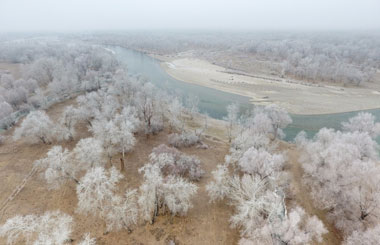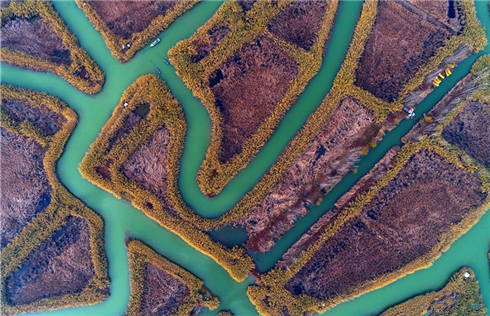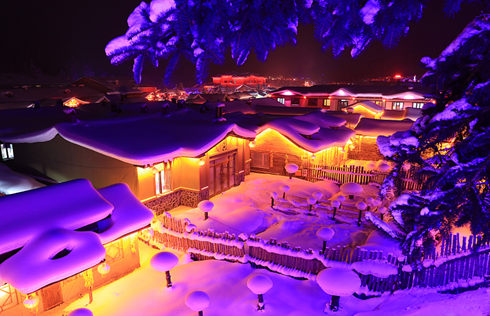A fast track scenic tour


Take a few breaks to enjoy the delights found along the route of the Wuhan-Guangzhou High-Speed Railway. Pan Jingping and Shen Weiping report
The Wuhan-Guangzhou High-Speed Railway running through Hubei, Hunan and Guangdong provinces is among the world's fastest railways. Trains reach a speed of 350 km/h, shortening the travel time between Wuhan and Guangzhou from 10 hours to three. The 1,068 km railway links the Zhujiang River Delta, Nanling Mountains, Hengshan Mountain, Xiangjiang River, Dongting Lake and Wuhan City, which makes traveling to the places along the railway a marvelous experience.
Shaoguan
The city of Shaoguan, located in northern Guangdong province, is known for Mount Danxia and Nanling National Forest Park. It is also home to the Guoshan Yao, a little-known ethnic group in Ruyuan county.
Mount Danxia, also known as the "Red Stone Park of China", is noted for its sandstone cliffs and flat valleys.
Along the road to Nanling National Forest Park, you will pass Nanshui Lake, the third-largest reservoir in the province.
Hidden deep inside Nanling Mountains and garnished with green valleys, the lake looks like a lotus nestling in an amphitheater of peaks.
The azure lake looks cool, and its 12 isles gleam reddish-orange in the twilight.
Near the gate of Nanling National Forest Park, there is a hotel called Orange House. Its bright orange color shines like a beacon at dusk, ensuring tourists won't get lost.
The hotel is the ideal place to taste the local specialty, shitou pork. The pork is chewy, the skin deliciously crisp and the fat far from greasy.
According to the waiter, locals feed their pigs a low-fat diet of corn, sweet potatoes and wild plants.
One great scenic spot is called "Nine Layers of Sky". Chinese often use nine to suggest a large number and on a clear day, one can see layer upon layer of densely wooded mountains, which appear black, cyan and emerald.
The park is also home to the picturesque Nine Mountain Falls.
After Nanling National Forest Park, one can visit Ruyuan county, where you can learn about the enigmatic Guoshan Yao, a branch of the Yao ethnic group.
The Guoshan Yao don't have their own written characters. To convey ideas, they use their extraordinary embroidery.
Local researcher Liu Yongxun has devoted himself to preserving the Yao traditional embroidery, which he says is irreplaceable, even though it is not as flamboyant or well-known as other schools of embroidery in the country.
"There are 31 special patterns in Yao embroidery such as deer and giant birds," Liu says. "They are abstract, but very intriguing."
"Unlike other schools of embroidery, Yao people use only five colors of silk. They stitch it without any draft, so it's very unique," Liu says.
Chenzhou
Further north along the railway is Chenzhou city, Hunan province, which is famous for the ancient Banliang village, a resort on Xiangling Mountain.
The first thing about the village that strikes a visitor is that every door is open. Elderly folks lie on bamboo beds, enjoying the occasional gentle breeze.
Walking down the main road of the village, which used to be part of an ancient trade route, one can reach the well preserved ancestral halls of Master Yu and Master Run, both are highly revered men in the long history of the Liu family.
Locals say their lineage comes all the way from Liu Che, or Emperor Wudi of the Han Dynasty (206 BC-AD 220). Since the Song Dynasty (960-1279), the Liu family has lived in Banliang village for 30 generations.
In the eastern lobby of the ancestral hall of Master Yu hangs an ancient imperial edict that praises the family's filial piety, generosity and harmony.
To observe the village's virtues, the best choice is Wulong (Five Dragons) Spring, where villagers have built three pools for drinking, laundering and dishwashing.
While young girls wash their long hair, women scrub clothing on the stones beside the pool and men pluck chicken feathers nearby.
The young boys in the village are very passionate about being sightseeing guides. They will lead you to the gigantic Jinye (Golden Leaf) tree at the foot of Xiangling Mountain.
Another place the boys like to show off to visitors is an ancient tower. It's said that the tower was once a nine-story structure. During the War of Resistance against Japanese Aggression (1937-45), a Japanese fighter jet accidentally struck the tower and crashed. With the two top levels destroyed, the tower became known as the "fighter killer".
Zhuzhou

The ribbon-like Xiangjiang River, which sweeps in a beautiful curve through Zhuzhou, Hunan province, is probably the city's most awe-inspiring scene. To fully appreciate it, you must go to Shifeng Park.
Located in downtown Zhuzhou and on the north bank of Xiangjiang River, the park offers various amusements, including a vintage carousel and a go-kart track.
But such excitements cannot compete with the ancient and more tranquil sites. In the forest is a cluster of ancient buildings with golden roofs. By a big pool are some elderly residents practicing tai chi.
They say that the best season to visit the park is early spring, when the hill is covered with pink cherry blossoms.
Yunfeng Tower at the peak of Shifeng Hill provides a panoramic view of the city. From here you can contemplate the green hues of the hills and woods, the gorgeous curve of Xiangjiang River and the distant wall of glittering high-rises.
The local government is renovating the banks along the Xiangjiang River so the man-made architecture will better blend in with the natural scenery.
Changsha
People visiting Changsha, the capital of Hunan province, for the first time, can feel the pulse of the city on an unusual "pedestrian walkway".
The Orange Isle (Juzizhou) lies in the center of Xiangjiang River and stretches 6 km from north to south.
On the isle stands a new statue of former chairman Mao Zedong in his youth. At 32 meters, the sculpture is the tallest statue of Mao ever built.
The statue features Mao's hair blowing in the wind, reminding people of Mao's famous poem:
"Alone I stand in the autumn old, on the tip of Orange Isle, the Xiangjiang River flowing northward."
As the name of the island indicates, Orange Isle is famous for its splendid orange grove, which has more than 400 kinds of oranges collected from places of the same latitude, including summer orange, mandarin orange, American navel orange and Japanese May shaddock.
Besides orange trees, there are also plum, bamboo, peach and cinnamon. In the forest are 13 buildings constructed since 1904, when the city opened a commercial port. Among them is the mansion of Tang Shengzhi, a senior Kuomintang leader during the War of Resistance against Japanese Aggression.
In the western part of the isle there are a 600-meter-long artificial beach and an outdoor swimming pool, which can hold as many as 10,000 people.
Yueyang
Thanks to Tuanhu Lake, Yueyang, Hunan province, can offer tourists both visual and gastronomic delights.
Located in Junshan district, Tuanhu Lake covers some 320 hectares. Compared to Dongting Lake, it is only a "teardrop", but it is studded with floating lily pads and large, broad lotus leaves, making it one of the largest lakes in Asia for wild lotuses.
A boat can easily become caught in the lotuses, so the boatmen navigate through the water with a long bamboo pole slowly and carefully.
As the boat inches its way forward, you will have plenty of time to observe the lotuses' kaleidoscopic colors: pink, amber, light green and gleaming white, and flowers of indigo blue, an exceptional species.
While most lotus leaves stand upright, providing shelter from the scorching sun, other mischievous leaves softly scratch your face or pat you gently on the back. When you see some seedpods that stretch into the boat, don't hesitate to pick them.
The lotus seeds grown in Tuanhu Lake are crowned as the top lotus seeds in China. It's very easy to break open a fully ripe seedpod for the fragrant seeds which Chinese doctors say are good for strengthening the kidney and liver.
The boatman says the lotuses in Tuanhu Lake bloom every season but the lotus seeds in summer taste the best.
Xianning
Xianning city in Hubei province has always been a destination for those in search of cleansing and healing natural hot springs.
Its therapeutic allure dates back to the Tang Dynasty (AD 618-907). Now, thermal spas sprout everywhere in the city.
The best spot to sample the waters is Taiyi Cave, which integrates the unique karst terrain with varied hot springs.
The cave is named after the legend of a Taoist deity, Taiyi Zhenren, who is said to have slaughtered demons here. At a length of 2,000 meters, the cave looks mysterious and it's a good idea to bring along a flashlight to explore it.
The most famous stalagmite in the cave looks like a sword-wielding man, none other than Taiyi Zhenren himself according to local legend. Other stalactites and stalagmites instill a sense of wonder and trigger the imagination.
Numerous bats hang upside down on the ceiling near the cave's exit, which is just a few steps away from some 30 hot springs.
Rose Spring is a steaming pool dotted with elegant, fresh rose pedals. Having a bath in such hot waters, you are surrounded with a deeply soothing aroma.
Likewise, the swimming-pool-like Asparagus Spring is highly beneficial to your skin. It is said dipping yourself in the bubbling spring can make your skin moist and baby soft, saving money on lotions or emollients.
Medlar Spring, Milk Spring and many others offer different kinds of relaxation and you can choose your favorite way to soak away your ailments, both real and imagined, in this fantastic array of hot springs in Xianning.

Wuhan
If you ask a Wuhan local the place that best represents the provincial capital of Hubei, you will probably get an answer like Tanhualin Historic Street Block.
Walking on this nearly 2 km block is like a journey through time.
Located at the northeast corner of Wuhan and lying between Huayuan Hill and Pangxiejia Hill, the block is filled with hoary walls, ancient steles, antiques stores and old consulates.
The block is the location of Huazhong Normal University and the former residence of Liu Gong, who founded Gong Jin Hui, a revolutionary organization that sought to overthrow the Qing Dynasty (1644-1911).
Liu and his comrades designed the legendary army flag of the 1911 Xinhai Revolution that finally ended China's feudal history.
But Tanhualin is not just a historic landmark. There are some art zones which are injecting a dose of vibrancy into the old street.
Rongyuan, a former missionary building established in 1920, has been turned into a chic caf. Its floor is still old and squeaky, but brightened by the pale yellow pools of light radiating from a fashionable lamp. Through the window, you can see a quintessentially British red brick corridor.
On Huayuan Hill, a former church now serves as a gallery, whose curator Xu Shiming excels in drawing plum blossoms. As the sun beams dance through the church window and illuminate the traditional ink and brush paintings, you may sense a delicate combination of Chinese and Western arts.
The story first appeared in Trends Traveler magazine.














